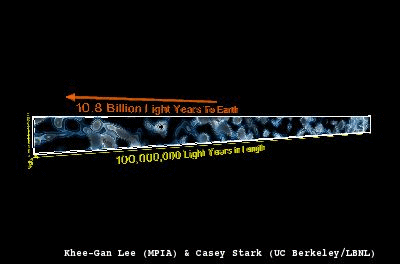A team led by astronomers from the Max Planck Institute for Astronomy has created the first three-dimensional map of the ‘adolescent’ Universe, just 3 billion years after the Big Seed. This map, built from data collected from the W. M. Keck Observatory, is millions of light-years across and provides a tantalizing glimpse of large structures in the ‘cosmic web’ – the backbone of cosmic structure.
On the largest scales, matter in the Universe is arranged in a vast network of filamentary structures known as the ‘cosmic web’, its tangled strands spanning hundreds of millions of light-years. Dark matter, which emits no light, forms the backbone of this web, which is also suffused with primordial hydrogen gas left over from the Big Bang. Galaxies like our own Milky Way are embedded inside this web, but fill only a tiny fraction of its volume.
Now a team of astronomers led by Khee-Gan Lee, a post-doc at the Max Planck Institute for Astronomy, has created a map of hydrogen absorption revealing a three-dimensional section of the universe 11 billions light years away – the first time the cosmic web has been mapped at such a vast distance. Since observing to such immense distances is also looking back in time, the map reveals the early stages of cosmic structure formation when the Universe was only a quarter of its current age, during an era when the galaxies were undergoing a major ‘growth spurt’.
The map was created by using faint background galaxies as light sources, against which gas could be seen by the characteristic absorption features of hydrogen. The wavelengths of each hydrogen feature showed the presence of gas at a specific distance from us. Combining all of the measurements across the entire field of view allowed the team a tantalizing glimpse of giant filamentary structures extending across millions of light-years, and paves the way for more extensive studies that will reveal not only the structure of the cosmic web, but also details of its function – the ways that pristine gas is funneled along the web into galaxies, providing the raw material for the formation of galaxies, stars, and planets.
Using the light from faint background galaxies for this purpose had been thought impossible with current telescopes – until Lee carried out calculations that suggested otherwise. To ensure success, Lee and his colleagues obtained observing time at Keck Observatory, home of the two largest and most scientifically productive telescopes in the world.
The resulting map of hydrogen absorption reveals a three-dimensional section of the universe 11 billions light years away – this is first time the cosmic web has been mapped at such a vast distance. Since observing to such immense distances is also looking back in time, the map reveals the early stages of cosmic structure formation when the Universe was only a quarter of its current age, during an era when the galaxies were undergoing a major ‘growth spurt’. The map provides a tantalizing glimpse of giant filamentary structures extending across millions of light-years, and paves the way for more extensive studies that will reveal not only the structure of the cosmic web, but also details of its function – the ways that pristine gas is funneled along the web into galaxies, providing the raw material for the formation of galaxies, stars, and planets.
The Low Resolution Imaging Spectrometer (LRIS) is a very versatile visible-wavelength imaging and spectroscopy instrument commissioned in 1993 and operating at the Cassegrain focus of Keck I. Since it has been commissioned it has seen two major upgrades to further enhance its capabilities: addition of a second, blue arm optimized for shorter wavelengths of light; and the installation of detectors that are much more sensitive at the longest (red) wavelengths. Each arm is optimized for the wavelengths it covers. This large range of wavelength coverage, combined with the instrument's high sensitivity, allows the study of everything from comets (which have interesting features in the ultraviolet part of the spectrum), to the blue light from star formation, to the red light of very distant objects. LRIS also records the spectra of up to 50 objects simultaneously, especially useful for studies of clusters of galaxies in the most distant reaches, and earliest times, of the universe.

